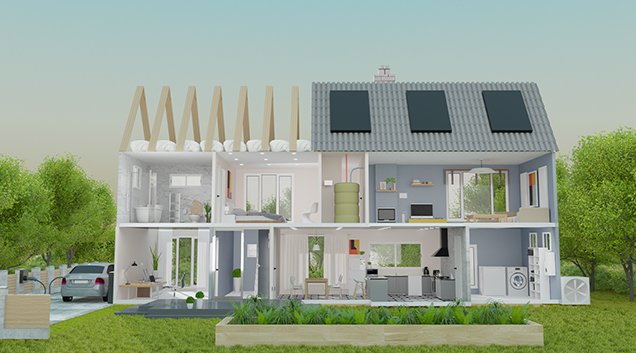How to save energy when heating your home

Our heating is perhaps the largest contributor to our overall energy bill. While it's imperative that we keep warm, especially during the colder winter months, there are a few ways that we can reduce our heating bill - and they're very simple.
Thermostat
Turn the thermostat for your living areas down to 20°C. The temperature in hallways and bedrooms should be cooler, ideally between 15-18°C. You can reduce your heating bill by 10% by lowering your room temperature by just one degree.
Heat pump
A heat pump is a machine that extracts heat from one place and transfers it to another. Refrigerators and air conditioners are both common examples of heat pumps. Heat pumps transfer heat by circulating a substance called a refrigerant through a cycle of alternating evaporation and condensation. A compressor pumps the refrigerant between two heat exchangers. In one heat exchanger, the evaporator, the refrigerant is evaporated at low pressure and absorbs heat from its surroundings.
The refrigerant is then compressed enroute to the second heat exchanger, the condenser, where it condenses at high pressure. At this point, it releases the free heat it absorbed earlier in the cycle. The heat from the fluid is transferred to the water in your heating system, including radiators and underfloor heating, as well as your hot water tank.
You could save up to 70% on your hot water with Electric Ireland’s Night Boost price plan for heat pump owners who also have a smart meter. The idea is to set the heat pump to switch on at 2am and maximise your savings by running other appliances at this time too.
Chimney
A chimney is just a hole in your house if you’re not using it to light a fire. Fill an unused chimney with a chimney balloon to stop heat escaping.
Radiators
If you’re lucky enough to have spare rooms that you do not use a lot, ensure you’re using a radiator valve to turn the temperature down or off. Put a reflector behind a radiator, and it will reflect the radiator’s heat back into your room instead of letting it seep out through the wall behind. Radiator reflectors can be bought by the roll in most hardware stores. Opting for shorter curtains above any radiators will ensure heat isn’t channelled towards the window, and instead is helping to keep the room cosy.
Windows
You lose around 85% of the heat in your home through poor insulation. Upgrading your kitchen windows to double glaze will keep that heat in, cut your emissions and save you money.
Bring me back to Interactive Home
Insulation
Did you know that the roof and attic can be responsible for up to 30% of heat lost in the average home? An inefficient home, one that has a Building Energy Rating (BER) of ‘G’, will cost around 10 times as much to heat as one rated ‘A’. In Ireland, all homes advertised for sale or lease since 2009 are required to display their BER so you may well have BER cert or at least know your home’s rating.
Heat rises, so it won’t be a huge surprise that the roof/attic is responsible for 30% or so of heat lost in the average home. What may surprise you is how attic insulation can lose its effectiveness. Loose-fibre insulators will settle over time and a poorly ventilated attic can cause insulation to become damp and rot.
Upgrading your attic insulation is generally very cost-effective, though the actual cost will vary depending on the size of your home. The results usually justify that initial outlay, on average new attic insulation can pay for itself in energy savings within around 3 years.
On average, your home will lose up to 35% of heat through its outer walls. If you have an older house with poor outer wall insulation, or no insulation at all, that heat loss will cost you a significant amount of money each year.
Unfortunately, inadequate or absent wall insulation can be expensive to remedy, but there are grants available for all BER-improvements including substantial rebates for outer and inner wall insulation.
Cracks or gaps in the outer walls can introduce a draught into your home or allow moisture to rot cavity wall insulation. Catching cracks or gaps early is a cheap and easy fix that will pay dividends.
BER rating
The BER is like a school report for your home, giving it an overall rating from A-G, with A being the most energy efficient and G being the least. As a rule of thumb, a building rated ‘G’ costs around 10 times as much to heat per year as one with an ‘A’ grade.
A BER is calculated by a BER assessor following a review of your property. During that review, the assessor will examine the insulation level and type in all areas of your home. They check your boiler’s age and condition and look at other factors like the size, type and condition of your windows and doors. The assessor also needs to check the roof and floor dimensions and examine air flow and ventilation of your home to come up with a final grade. They will consider any energy efficiency improvements or technology like solar panels, battery storage units or storage heaters too.
Knowing where your home needs to be improved is a huge start in improving your BER and making it more energy efficient. A quick chat with your Assessor will help point you in the right direction for any potential improvements.
You may already know that around 35% of heat lost from the average home escapes through the outer walls with up to 30% leaving through the roof. Looking at the suitability of your wall or attic insulation and checking for gaps or cracks is the first step in reducing that heat loss.
Another set of potential energy wasters are windows and doors. Single-paned windows unsealed outer doors or any poorly fitted frames will lose you up to 25% of your home’s heat.
You also need to be aware that poorly performing windows or doors (and the draught that often comes with them) will greatly reduce the effectiveness of attic and wall insulation.
The Electric Ireland Interactive Home is a one-stop shop for all your energy-saving needs. Explore the home to find out which appliances you can save energy on. Reducing energy means doing your bit for the environment - and your pocket.
Read more: How to save energy on your home appliances
Read more: How to save energy on everyday household items
Follow Electric Ireland on social media: Twitter: @electricireland Facebook: @ Electric Ireland Instagram: @electricireland



